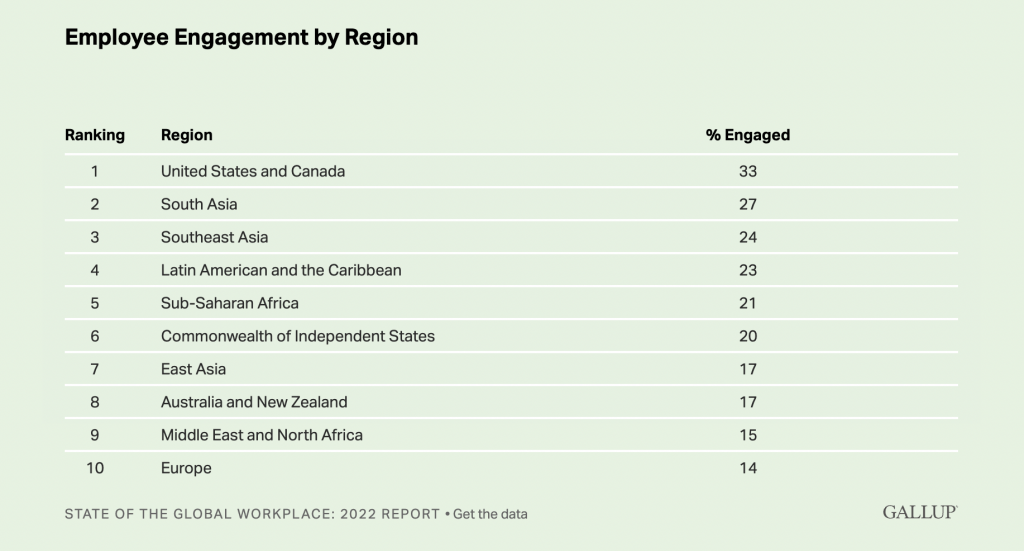Triggers of Quiet Quitting and Ways for HR and People Leaders to Tackle It
8 min read

Is quiet quitting the new rising paradigm in the workplace following the more established Great Resignation trend? Maybe it’s a latent problem shadowing in the background of our organizations that now surfaced and is forcing us to take action. Or perhaps it’s just a new buzzword or misnomer since quiet quitting does not mean quitting your actual job.
Opinions vary in this regard, but no matter the side you are in, we must identify the roots of the problem and find the right ways to fix it. But let’s start with the beginning.
What is quiet quitting and what are the triggers?
In a nutshell, quiet quitting means avoiding the above and beyond at work while just performing the necessary tasks at a bare minimum to meet the job description.
As Rae D’Umay – Human-Centered Designer and Organizational Transformation consultant – has recently shared with us: “There has been some forms or manifestations of quiet quitting taking place worldwide for decades. Often it has been labeled as some form of “worker slow down”, at best, to “worker sabotage”, at worst. Moreover, data supporting the long-term trends and truth that quiet quitting is NOT something new goes a long way back”.
Still, following a TikTok video posted this July with the message: “You are still performing your duties but you’re no longer subscribing to the hustle culture mentality that work has to be your life” this trend suddenly became mainstream.
Should this be something to worry about?
Rae D’Umay points out that Gallup has long established the devastating and costly impacts of feeling a lack of value and personal contribution at work, which directly links to engagement and outcomes.
According to one of the latest Gallup research, “quiet quitters” make up at least 50% of the U.S. workforce. At the same time engagement in the workplace ranks poorly, only between 14 and 33 percent depending on the region considered.

Deborah Denyer – Executive coach specializing in Leadership Development programs – also believes that the decision to ‘quiet quit’ has been triggered by feeling undervalued. “Boundaries have been overstepped. Resentment builds. Motivation and commitment diminish. It’s often a form of self-preservation, where an employee has decided that they can no longer give so much of themselves. They often don’t feel comfortable broaching the topic or feel they won’t be heard.”
What are the hidden downsides of quiet quitting?
Since people who are “quiet quitters” are actually performing their daily tasks just refusing to get involved more, some might be tempted to think there is nothing wrong with this in the first place. The truth is that these types of attitudes have multiple downsides as shared with us by Deborah Denyer.
For the organization, quiet quitting results in reduced engagement, lower productivity, and impacts team morale. Yet it’s not a decision that’s made lightly, it often reduces job satisfaction, motivation, a sense of purpose, and future career prospects.
— Deborah Denyer
Further on, quiet quitting brings up some negative cascading effects. For example, if one of the colleagues in the team becomes disinterested in his work anymore, they might negatively influence the attitudes of others.
Also, an employee who is performing his tasks at a bare minimum means one way or another increased workloads for other peers. The overall productivity and performance of the team might be affected as also the morale. It can result in deep frustration, inequalities in the workplace, and even burnout for colleagues who will constantly be forced to make greater efforts to balance the results of the team. This is an extremely harmful situation in the long run.
Looking from a different perspective, it’s difficult to assume change or strategic projects with “quiet quitters”. These people will tend to do less and only related to their work. They will feel uncomfortable working in large teams, disengaged in additional activities, helping others, or testing new ideas. Therefore this kind of behavior cannot drive growth or innovation.
What can HR and People Leaders do to prevent quiet quitting
Rae D’Umay has some positive thoughts on this. Following her extensive expertise of more than 20 years in working with people, she believes each individual brings inherent skills, talents, strengths, AND gifts to bear which they are ready to share inside their workplace IF they are invited to.
Grow your leaders to become better people managers
An article published recently by Harvard Business Review shows the results of data gathered since 2020 on 2,801 managers, who were rated by 13,048 direct reports. The research links directly the quiet quitting behavior to less effective managers who lack leadership skills.
In our opinion, managers have a big responsibility in finding a balance between assuming the business outcomes of the company as well as showing care and genuine interest in their teams. Those leaders who have the capacity to understand they can only achieve business goals with the help of their people are the ones who will be able to keep their people motivated and willing to make extra efforts.
That’s why leaders who lack communication skills, empathy, and the ability to create bonds that inspire trust should focus on cultivating these types of behavioral skills.
“As a direct supervisor or manager, shifting the way team members or contributors are viewed and treated is paramount. This cannot be stressed enough” adds Rae.

Create a workplace where people want to go the extra mile
There are some key elements that contribute to a positive work environment where people are eager to make extra efforts so that their organization succeeds.
- Meaningful work – This is an important crucial point, especially for younger generations. People want to get a sense of their work value and have clear visibility of how their tasks contribute to a higher goal. So don’t hesitate to get people involved in the process by helping them set clear trackable objectives in line with your business strategic direction.
- Belonging and inclusion – foster a culture where everyone feels valued, and get fair treatment no matter the age, gender, or cultural disparities.
- Growth opportunities – Lack of growth opportunities is one of the top reasons people leave their jobs. This reason ranks even above an inadequate compensation package. Encourage your people on the path of growth and career development and help them develop new skills and capabilities.
- Open conversations and feedback – Make the time to have open, genuine conversations with your people. It will pay off each step of the way. Try to listen actively but also collect feedback. Genuine interest and care boost psychological safety, and this is the climate where people can feel engaged to contribute and give the most. When it comes to quiet quitting don’t jump to biased conclusions. Try to understand if they just need to set a stricter barrier between work or personal life or what other difficulties they might encounter.
For additional advice on how to have more meaningful 1:1s, visit our dedicated resource on the topic.
Deborah Denyer is an advocate herself to open constructive communication. “Too often managers assume employees will be motivated by the salary or perks. People are complex and diverse. When managers have conversations with their employees to understand what motivates them, what their strengths and aspirations are, how they like to work, and what they need to be at their best, employees feel valued. When you feel valued, you’re far more likely to give your all, rather than the bare minimum,” adds Deborah.
Set the framework for a truly consistent employee experience
From the first interaction of a candidate with your company and throughout the whole employee lifecycle, try to create a positive experience where people are valued and heard and their expectations are met. Technology can play a big role in this aspect.
Use pulse surveys, 360-feedback, performance reviews, or self-assessment tools to understand different expectations people have regarding the work environment, the climate in the company, their personal growth and career development opportunities, as well as compensations and benefits.
Once you understand what people want, you can use people analytics and smart nudges so you can truly commit to a consistent employee experience at every level.
Final thoughts
Create the conditions where each person is afforded agency and sovereignty, where their contributions are welcome and matter, and quiet quitting or other forms of resistance will be a thing of the past. This work takes effort, time, dedication, and discipline - AND can be achieved
— Rae D'Umay










